Carbon Footprint of Electricity Generation in Brazil: An Analysis of the 2016–2026 Period
Abstract
1. Introduction
1.1. Generation of Electricity in the Global Scenario
1.2. Production of Electricity in Brazil
1.3. Life Cycle Assessment
1.4. Global Discussion on LCA of Electricity Systems
1.5. Brazilian Discussions on LCA of Electricity Systems
1.6. Purpose and Scope of the Analysis
2. Characterization of the Brazilian Electricity Matrix
3. Methodology
3.1. LCA
3.1.1. Purpose, Scope and Inventory Analysis
3.1.2. Impact Assessment
3.1.3. Adaptations, Assumptions and Cut Criteria
- All sources were considered high voltage; only the solar was adapted to low voltage, because it was the only option in the database.
- The solar energy system presented photovoltaic panels with 570 kWp (kilowatt power) with open ground installation.
- The only source for which data were not from Brazil was the solar, where the geography used was the “Rest of World” (RoW).
- Process names and specific emissions for each technology are found in Table.
3.2. Scenario Definition to Perform the LCA and Construction of the LCI
4. Results and Discussions
5. Conclusions
Author Contributions
Acknowledgments
Conflicts of Interest
References
- Ministry of Mines and Energy (MME), National Energy Balance (BEN). 2016. Available online: https://ben.epe.gov.br/downloads/Relatorio_Final_BEN_2016.pdf (accessed on 22 April 2018).
- Vougioukli, A.Z.; Didaskalou, E.; Georgakellos, D. Financial appraisal of small hydro-power considering the cradle-to-grave environmental cost: A case from Greece. Energies 2017, 10, 430. [Google Scholar] [CrossRef]
- Montes-Romero, J.; Piliougine, M.; Muñoz, J.V.; Fernández, E.F.; Casa, J. Photovoltaic device performance evaluation using an open-hardware system and standard calibrated laboratory instruments. Energies 2017, 10, 1869. [Google Scholar] [CrossRef]
- Lund, H.; Mathiesen, B.V.; Christensen, P.; Schmidt, J.H. Energy system analysis of marginal electricity supply in consequential LCA. Int. J. Life Cycle Assess. 2010, 15, 260–271. [Google Scholar] [CrossRef]
- Dale, A.T.; Lucena, A.F.P.; Marriott, J.; Borba, B.S.M.C.; Schaeffer, R.; Bilec, M.M. Modeling future life-cycle greenhouse gas emissions and environmental impacts of electricity supplies in Brazil. Energies 2013, 6, 3182–3208. [Google Scholar] [CrossRef]
- International Organization for Standardization (ISO). Environmental Management—Life Cycle Assessment—Principles and Framework, 2nd ed.; ISO 14040:2006; ISO: Geneva, Switzerland, 2006. [Google Scholar]
- International Organization for Standardization (ISO). Environmental Management—Life Cycle Assessment—Requirements and Guidelines, 1st ed.; ISO 14044:2006; ISO: Geneva, Switzerland, 2006. [Google Scholar]
- Luz, L.M.; Francisco, A.C.; Piekarski, C.M. Proposed model for assessing the contribution of the indicators obtained from the analysis of life-cycle inventory to the generation of industry innovation. J. Clean. Prod. 2015, 96, 339–348. [Google Scholar] [CrossRef]
- Lelek, L.; Kulczycka, J.; Lewandowska, A.; Zarebska, J. Life cycle assessment of energy generation in Poland. Int. J. Life Cycle Assess. 2016, 21, 1–14. [Google Scholar] [CrossRef]
- Omwoma, S.; Lalah, J.O.; Kueppers, S.; Wang, Y.; Lenoir, D.; Schramm, K.W. Technological tools for sustainable development in developing countries: The example of Africa, a review. Sustain. Chem. Pharm. 2017, 6, 67–81. [Google Scholar] [CrossRef]
- Piekarski, C.M.; Francisco, A.C.; Luz, L.M.; Kovaleski, J.L.; Silva, D.A.L. Life cycle assessment of medium-density fiberboard (MDF) manufacturing process in Brazil. Sci. Total Environ. 2017, 575, 103–111. [Google Scholar] [CrossRef] [PubMed]
- Treyer, K.; Bauer, C.; Simons, A. Human health impacts in the life cycle of future European electricity generation. Energy Policy 2014, 74, S31–S44. [Google Scholar] [CrossRef]
- Şengül, H.; Bayrak, F.; Köksal, M.A.; Ünver, B. A cradle to gate life cycle assessment of Turkish lignite used for electricity generation with site-specific data. J. Clean. Prod. 2016, 129, 478–490. [Google Scholar] [CrossRef]
- Atilgan, B.; Azapagic, A. Assessing the environmental sustainability of electricity generation in Turkey on a life cycle basis. Energies 2016, 9, 31. [Google Scholar] [CrossRef]
- Berrill, P.; Arvesen, A.; Scholz, Y.; Gils, H.C.; Hertwich, E.G. Environmental impacts of high penetration renewable energy scenarios for Europe. Environ. Res. Lett. 2016, 11, 014012. [Google Scholar] [CrossRef]
- Garcia, R.; Marques, P.; Freire, F. Life-cycle assessment of electricity in Portugal. Appl. Energy 2014, 134, 563–572. [Google Scholar] [CrossRef]
- Asdrubali, F.; Baldinelli, G.; D’alessandro, F.; Scrucca, F. Life cycle assessment of electricity production from renewable energies: Review and results harmonization. Renew. Sustain. Energy Rev. 2015, 42, 1113–1122. [Google Scholar] [CrossRef]
- Wolfram, P.; Wiedmann, T.; Diesendorf, M. Carbon footprint scenarios for renewable electricity in Australia. J. Clean. Prod. 2016, 124, 236–245. [Google Scholar] [CrossRef]
- Kadiyala, A.; Kommalapati, R.; Huque, Z. Evaluation of the Life Cycle Greenhouse Gas Emissions from Different Biomass Feedstock Electricity Generation Systems. Sustainability 2016, 8, 1181. [Google Scholar] [CrossRef]
- Raj, R.; Ghandehariun, S.; Kumar, A.; Linwe, M. A well-to-wire life cycle assessment of Canadian shale gas for electricity generation in China. Energy 2016, 111, 642–652. [Google Scholar] [CrossRef]
- Santos, M.J.; Ferreira, P.; Araújo, M.; Portugal-Pereira, J.; Lucena, A.F.P.; Schaeffer, R. Scenarios for the future Brazilian power sector based on a multi-criteria assessment. J. Clean. Prod. 2017, 167, 938–950. [Google Scholar] [CrossRef]
- Geller, M.T.B.; Meneses, A.A.M. Life cycle assessment of a small hydropower plant in the Brazilian Amazon. J. Sustain. Dev. Energy Water Environ. Syst. 2016, 4, 379–391. [Google Scholar] [CrossRef]
- Restrepo, A.; Bazzo, E.; Miyake, R. A life cycle assessment of the Brazilian coal used for electric power generation. J. Clean. Prod. 2015, 92, 179–186. [Google Scholar] [CrossRef]
- Guerra, J.P.M.; Coleta, J.R.; Arruda, L.C.M.; Silva, G.A.; Kulay, L. Comparative analysis of electricity cogeneration scenarios in sugarcane production by LCA. Int. J. Life Cycle Assess. 2014, 19, 814–825. [Google Scholar] [CrossRef]
- Oebels, K.B.; Pacca, S. Life cycle assessment of an onshore wind farm located at the northeastern coast of Brazil. Renew. Energy 2013, 53, 60–70. [Google Scholar] [CrossRef]
- Ribeiro, F.M.; Silva, G.A. Life-cycle inventory for hydroelectric generation: A Brazilian case study. J. Clean. Prod. 2010, 18, 44–54. [Google Scholar] [CrossRef]
- Carvalho, M.; Delgado, D. Potential of photovoltaic solar energy to reduce the carbon footprint of the Brazilian electricity matrix. LALCA-Revista Latino Americana em Avaliação do Ciclo de Vida 2017, 1, 64–85. [Google Scholar] [CrossRef]
- Ecoinvent. Data Base. 2016. Available online: http://www.ecoinvent.org/database/database.html (accessed on 22 April 2018).
- Ministry of Mines and Energy (MME). Plan for the Expansion of Energy 2026; MME: Federal District, Brazil, 2017. Available online: http://www.epe.gov.br/sites-pt/publicacoes-dados-abertos/publicacoes/PublicacoesArquivos/publicacao-40/PDE2026.pdf (accessed on 6 April 2018).
- National Electric Energy Agency. Generation Information Database (BIG); ANEEL: Federal District, Brazil, 2017. Available online: http://www2.aneel.gov.br/aplicacoes/capacidadebrasil/OperacaoCapacidadeBrasil.cfm (accessed on 6 April 2018).
- Batista, A.A.S.; Francisco, A.C. Organizational Sustainability Practices: A Study of the Firms Listed by the Corporate Sustainability Index. Sustainability 2018, 10, 226. [Google Scholar] [CrossRef]
- European Fluorocarbons Technical Committee (EFCTC). 2016. Available online: https://www.fluorocarbons.org/wp-content/uploads/2016/09/EFCTC_Learn_about_GTP_versus_GWP.pdf (accessed on 4 April 2018).
- Irving, W.; Tailakov, O. CH4 Emissions: Coal Mining and Handling. Good Practice Guidance and Uncertainty Management in National Greenhouse Gas Inventories. 1999. Available online: https://www.ipcc-nggip.iges.or.jp/public/gp/bgp/2_7_Coal_Mining_Handling.pdf (accessed on 22 April 2018).
- Silva, R.; Pires, M.; Azevedo, C.M.N.; Fagundes, L.; Garavaglia, L.; Gomes, C.J.B. Monitoring light hydrocarbons in Brazilian coal mines and in confined coal samples. Int. J. Coal Geol. 2010, 84, 269–275. [Google Scholar] [CrossRef]
- Miranda-Santos, S.F.O.; Piekarski, C.M.; Ugaya, C.M.L.; Donato, D.B.; Braghini Júnior, A.; Francisco, A.C.; Carvalho, A.M.M.L. Life cycle analysis of charcoal production in masonry kilns with and without carbonization process generated gas combustion. Sustainability 2017, 9, 1558. [Google Scholar] [CrossRef]
- Raugei, M.; Leccisi, E. A comprehensive assessment of the energy performance of the full range of electricity generation technologies deployed in the United Kingdom. Energy Policy 2016, 90, 46–59. [Google Scholar] [CrossRef]
- United Nations (UN). 17 Goal to Transform our World: Goal 7: Ensure Access to Affordable, Reliable, Sustainable and Modern Energy for All. 2016. Available online: http://www.un.org/sustainabledevelopment/energy/ (accessed on 3 November 2016).
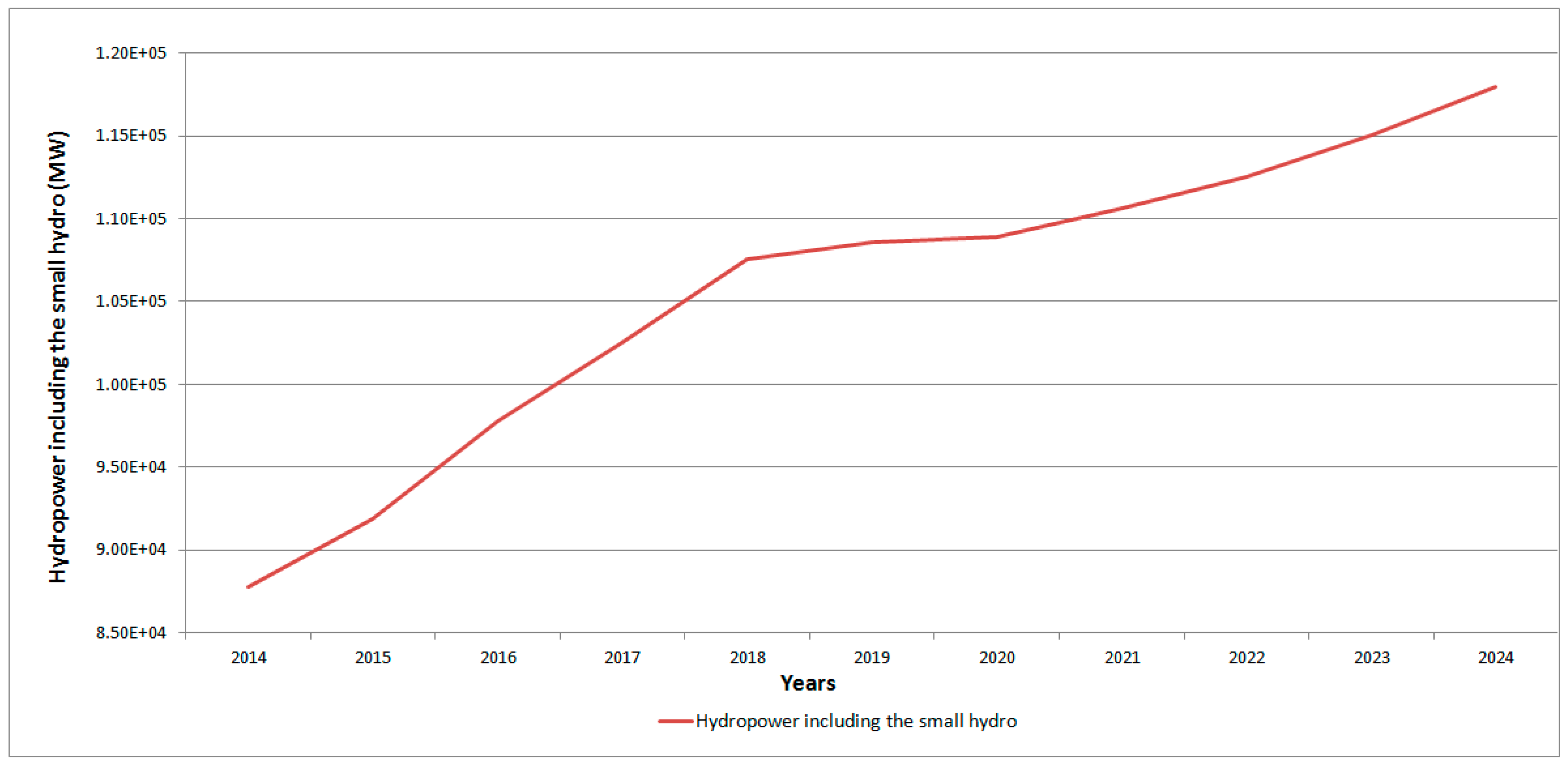
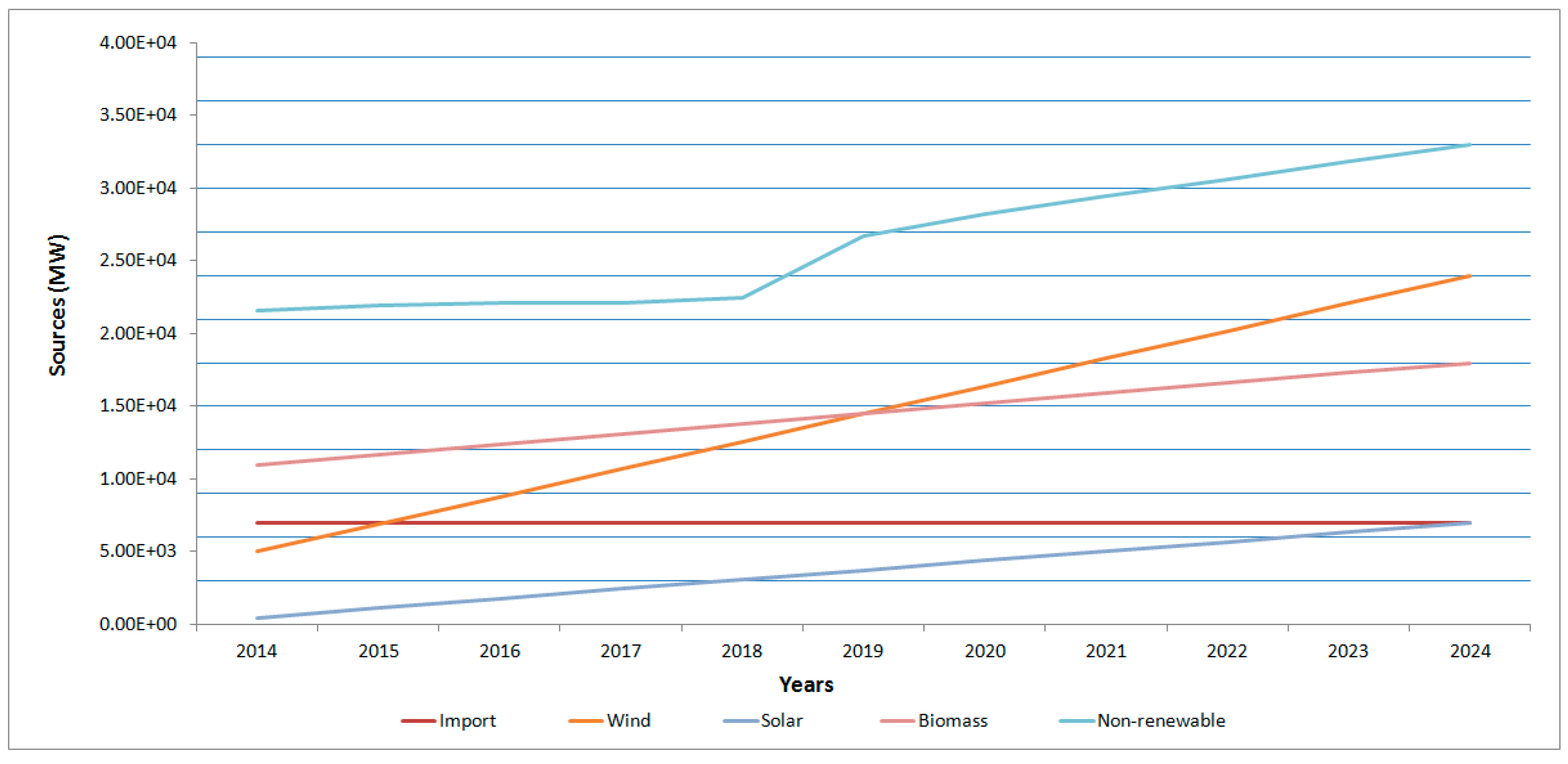
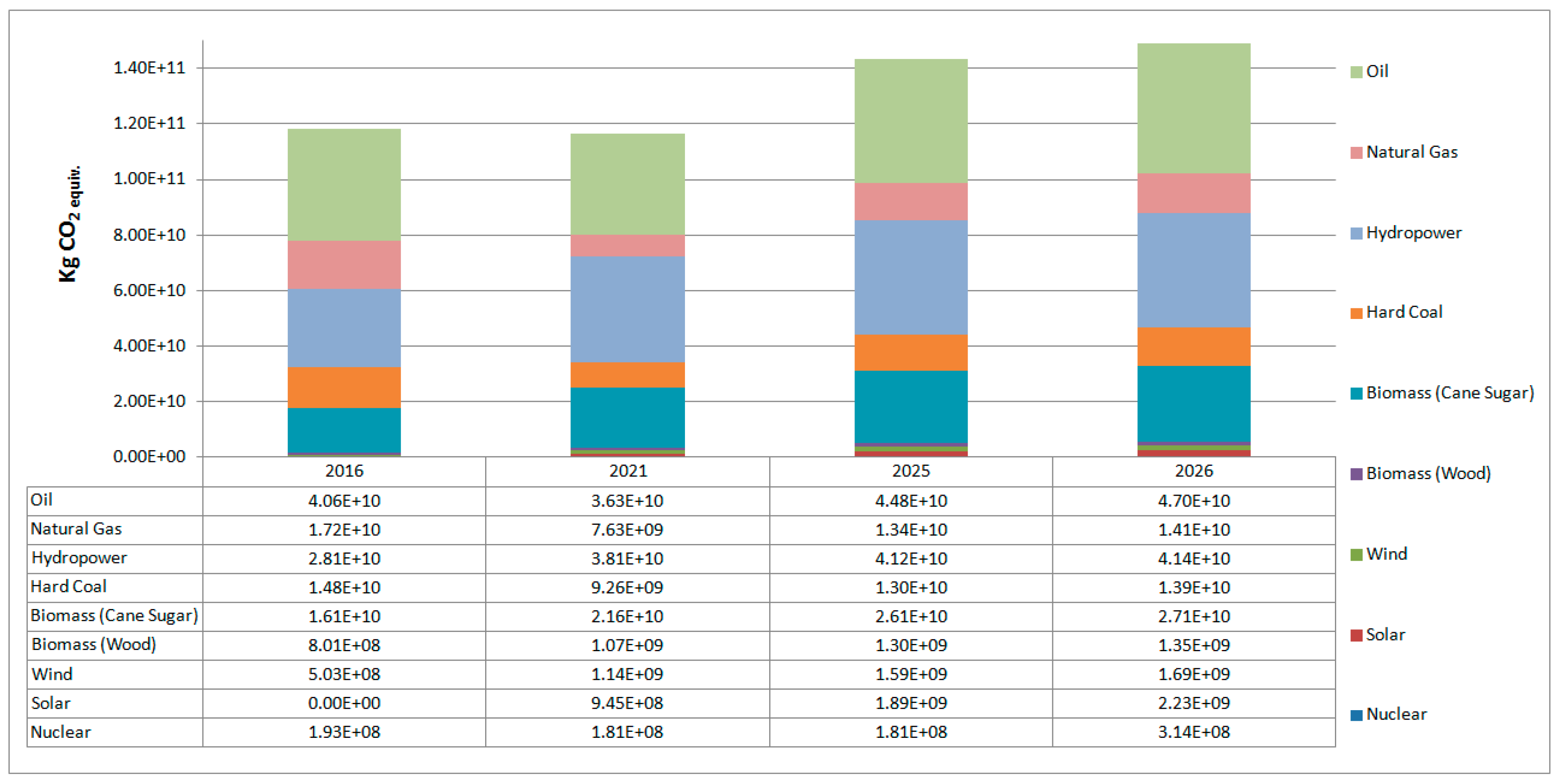
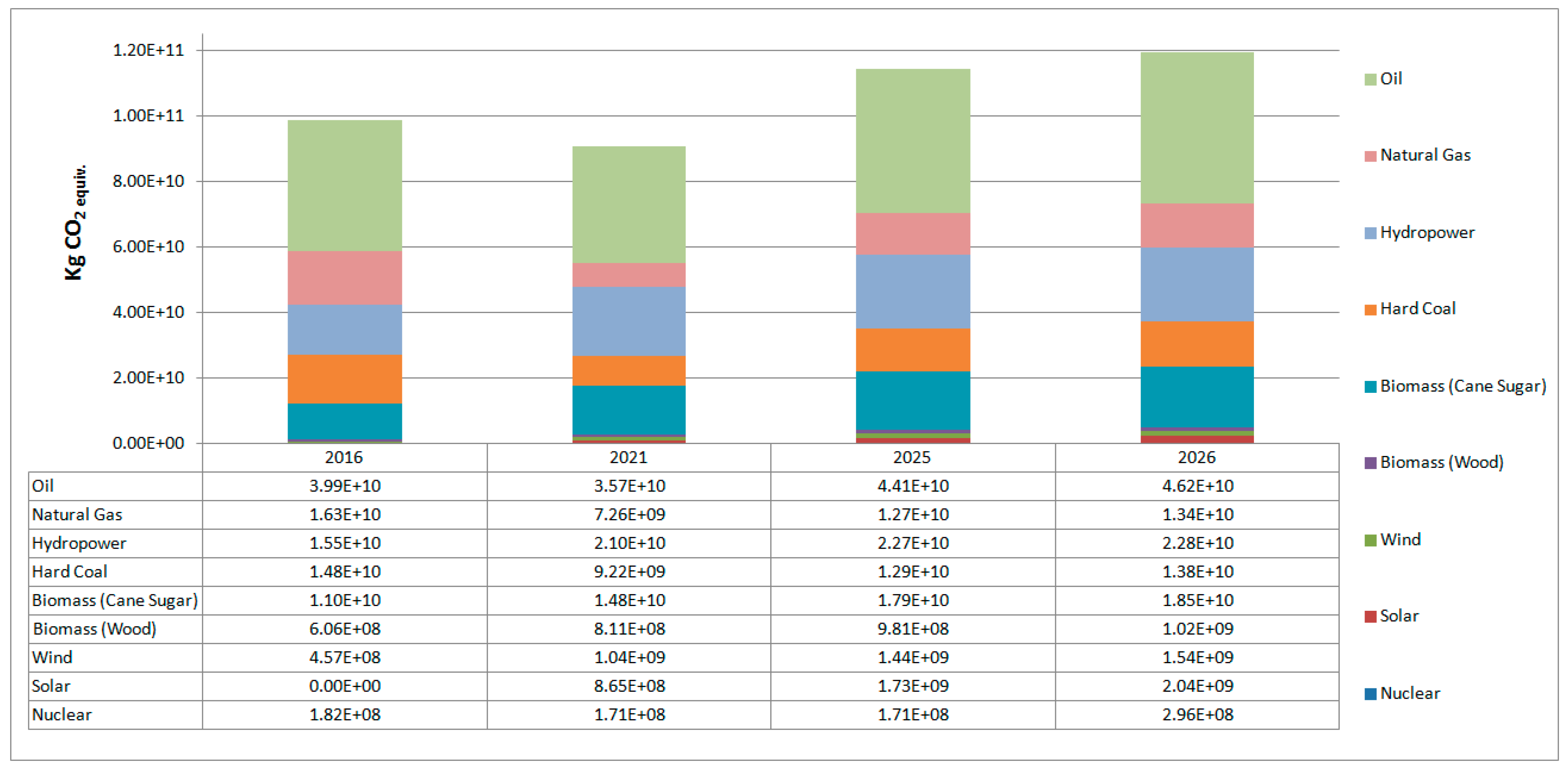
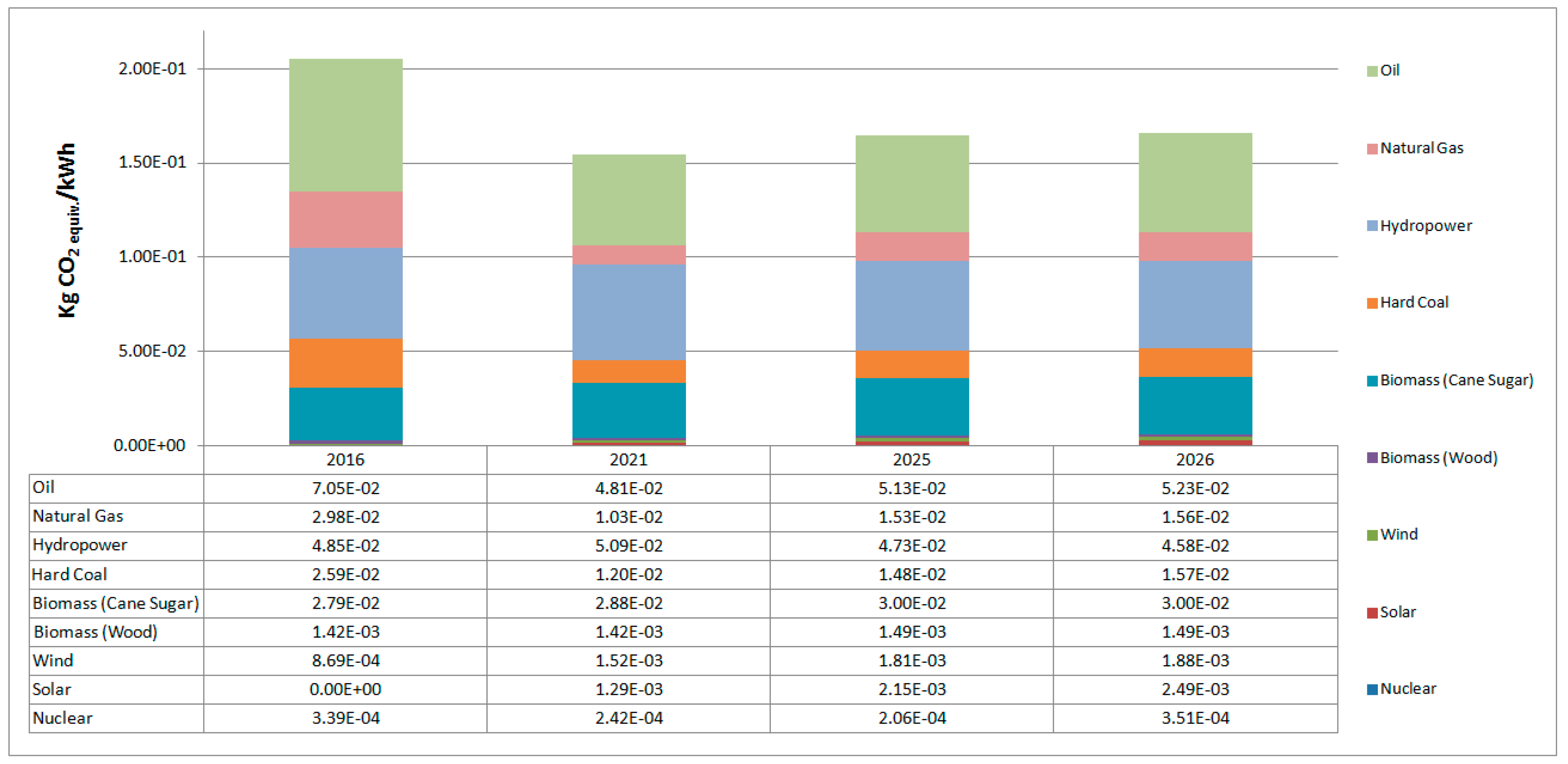
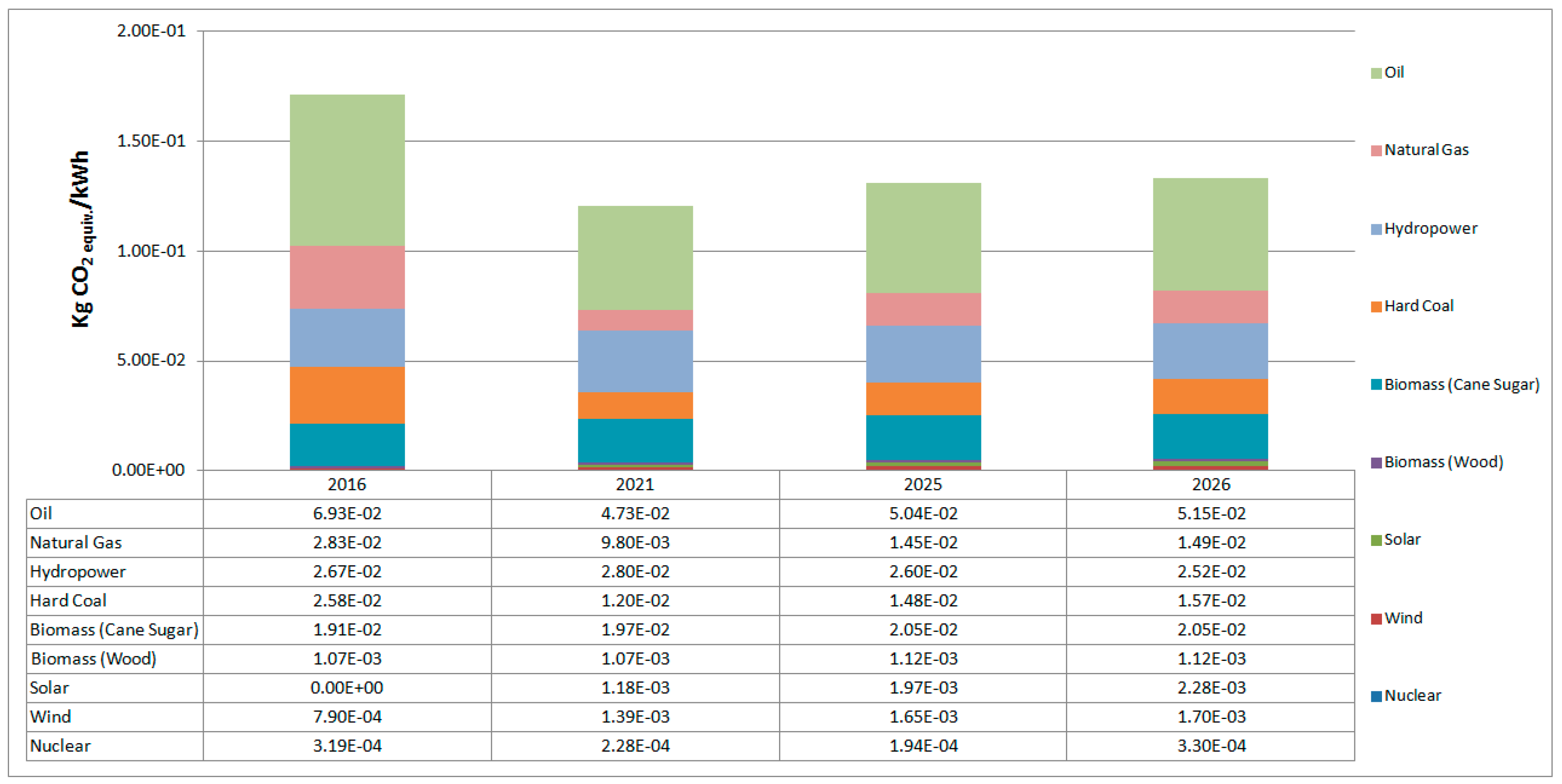
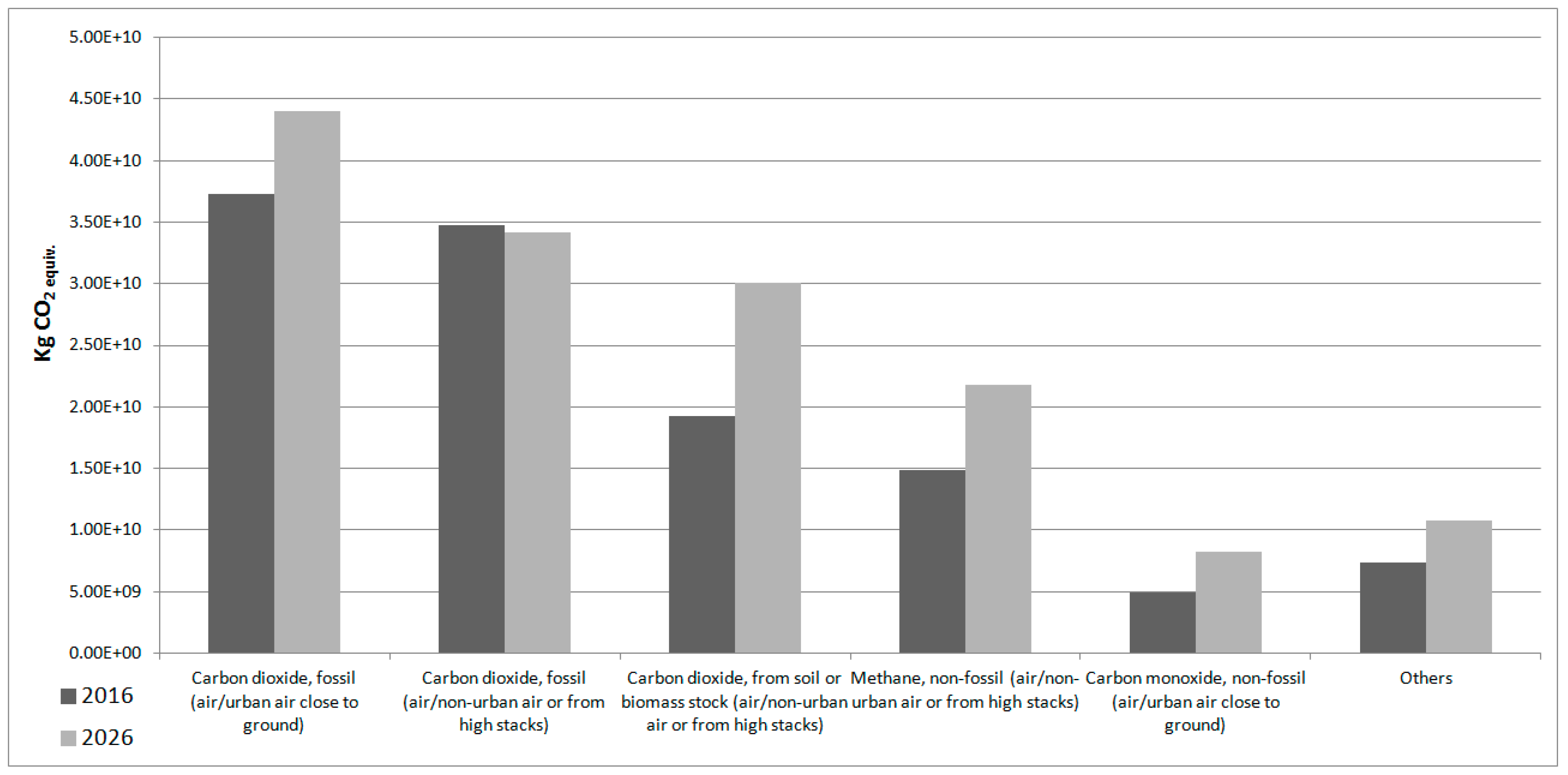
| Sources | Process Names | Emissions (kg CO2equiv./kWh) |
|---|---|---|
| Hydropower | electricity production, hydro, reservoir, tropical region [BR] Allocation, cut-off | 0.07378 |
| Wind | electricity production, wind, 1–3 MW turbine, onshore [BR] Allocation, cut-off | 0.01525 |
| Solar | electricity production, photovoltaic, 570 kWp open ground installation, multi-Si [RoW] Allocation, cut-off | 0.08591 |
| Biomass (sugar cane) | cane sugar production with ethanol by-product [BR] Allocation, cut-off | 0.4171 |
| Biomass (wood and others) | heat and power co-generation, wood chips, 6667 kW, state-of-the-art 2014 [BR] Allocation, cut-off) | 0.05906 |
| Nuclear | electricity production, nuclear, pressure water reactor [BR] Allocation, cut-off | 0.01209 |
| Natural gas | electricity production, natural gas, combined cycle power plant [BR] Allocation, cut-off | 0.3816 |
| Hard coal | electricity production, hard coal [BR] Allocation, cut-off | 0.9264 |
| Oil | electricity production, oil [BR] Allocation, cut-off | 1.068 |
| Sources | 2016 TWh | 2021 TWh | 2025 TWh | 2026 TWh | 2016 % | 2021 % | 2025 % | 2026 % | Reference |
|---|---|---|---|---|---|---|---|---|---|
| Hydropower | 381 | 517 | 559 | 561 | 65.80 | 69.03 | 64.11 | 62.06 | A |
| Wind | 33 | 75 | 104 | 111 | 5.70 | 10.01 | 11.93 | 12.28 | A |
| Solar | 0 | 11 | 22 | 26 | 0 | 1.47 | 2.25 | 2.88 | A |
| Biomass (sugar cane) | 38 | 51 | 62 | 65 | 6.68 | 6.92 | 7.19 | 7.19 | A and B |
| Biomass (wood and others) | 11 | 15 | 18 | 18 | 1.95 | 2.02 | 2.10 | 2.10 | A and B |
| Nuclear | 16 | 15 | 15 | 26 | 2.76 | 2.00 | 1.72 | 2.88 | A |
| Natural gas | 45 | 20 | 35 | 37 | 7.77 | 2.67 | 4.01 | 4.09 | A |
| Hard coal | 16 | 10 | 14 | 15 | 2.76 | 1.34 | 1.61 | 1.66 | A |
| Oil | 38 | 34 | 42 | 44 | 6.56 | 4.54 | 4.82 | 4.87 | A and B |
| Total | 579 | 749 | 872 | 903 | 100.00 | 100.00 | 100.00 | 100.00 | A |
© 2018 by the authors. Licensee MDPI, Basel, Switzerland. This article is an open access article distributed under the terms and conditions of the Creative Commons Attribution (CC BY) license (http://creativecommons.org/licenses/by/4.0/).
Share and Cite
Barros, M.V.; Piekarski, C.M.; De Francisco, A.C. Carbon Footprint of Electricity Generation in Brazil: An Analysis of the 2016–2026 Period. Energies 2018, 11, 1412. https://doi.org/10.3390/en11061412
Barros MV, Piekarski CM, De Francisco AC. Carbon Footprint of Electricity Generation in Brazil: An Analysis of the 2016–2026 Period. Energies. 2018; 11(6):1412. https://doi.org/10.3390/en11061412
Chicago/Turabian StyleBarros, Murillo Vetroni, Cassiano Moro Piekarski, and Antonio Carlos De Francisco. 2018. "Carbon Footprint of Electricity Generation in Brazil: An Analysis of the 2016–2026 Period" Energies 11, no. 6: 1412. https://doi.org/10.3390/en11061412
APA StyleBarros, M. V., Piekarski, C. M., & De Francisco, A. C. (2018). Carbon Footprint of Electricity Generation in Brazil: An Analysis of the 2016–2026 Period. Energies, 11(6), 1412. https://doi.org/10.3390/en11061412






